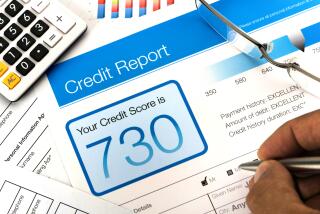How to Establish, Then Safeguard, Your Credit
- Share via
Anyone who has ever tried to buy a house or a car knows that credit is important. It often means the difference between having the ability to buy what you want and going without.
Nevertheless, many people ruin their own credit solely because they are careless. Those who follow a few simple rules should be able to avoid credit problems in all but the most extreme circumstances, such as the sudden loss of a job or a costly and unexpected illness. And they should be able to maintain a clean record that will nearly assure further credit approval when appropriate.
Here is a step-by-step guide on how to establish and maintain a clean credit record and what to do if you get into trouble with your debts.
Getting Started
Those who have never had a credit card often face a Catch-22 situation when applying for a loan. Without credit, you can’t get credit--or so it seems.
But there are several ways to establish a credit record. One is simply to open a checking or savings account. Banks will often offer credit cards to their reliable customers.
Some credit card issuers have easier approval standards for college students. If you’ve never had a loan before and American Express offers a pre-approved card, it might be worth the $35 annual fee to establish a credit record before you graduate.
If your current lack of credit is due to a bankruptcy or other past problems, some companies will still provide you with a secured credit card. What this usually means is that you have to deposit money with the company before it will issue you a card. This is sometimes the best you can do to re-establish a credit record and have the ability to handle emergencies with something other than cash.
Another option: You might be able to persuade a friend or relative to co-sign a credit application. This allows the bank to look beyond your poor or absent credit record to the record of your co-signer. Co-signers should be wary, though. They are on the hook for the other person’s debt, no matter how gigantic that debt becomes.
Maintaining Credit
The first step to maintaining good credit is to examine your financial picture. Figure out how much you take home each month and how much of that is spent on necessary living expenses, such as housing, car payments, insurance, food and utilities. Also subtract a reasonable figure for things you simply want, such as entertainment and savings. Whatever is left over you can use to service debt.
Realize, though, that credit is often expensive. And that makes it a poor choice for the purchase of smaller items that you could simply buy with cash.
You want to be able to borrow to buy a house or a car or to handle emergencies. But to have a $1,000 revolving balance on your department store charge because you went wild in the shoe department is stupid. Over the course of a year, you’ll pay more than $200 for the luxury of using plastic. Wouldn’t you rather spend that money on shoes, Imelda?
Handling a Crisis
So what happens if a job loss, an illness or poor credit management renders you unable to meet all your monthly obligations? Your handling of the crisis will be pivotal to your long-term credit standing.
You should immediately work out a new budget with an eye to cutting where you can. Then contact your creditors and tell them what’s happening. In many cases you will be able to extend the term of your loans and reduce minimum monthly payments.
If you need help, contact a Consumer Credit Counseling Service office. This nonprofit organization will help you work out a budget and payment plans with creditors. In Los Angeles, it can be reached at (213) 386-7601; in New York, the number is (212) 675-5070. There are hundreds of other offices across the country, which are normally listed in the phone book.
Fixing an Error
If you have been turned down for a loan and suspect that the reason is a negative credit report, you might want to take a look at the report and check its accuracy. Errors can be easily erased.
How do you get your credit report? If you’ve been turned down for a loan in the past 30 days, you can get a copy of your report free from any or all of the major credit reporting bureaus--TRW, Equifax and Trans-Union. If you haven’t been turned down for a loan, you may have to pay a fee, which usually amounts to less than $10.
The credit reporting service also might require you to request the report in writing, including your name, Social Security number, date of birth and address.
When you get the report, look for errors. When you find one, write next to the item that it is inaccurate and why.
In some cases, you might also want to dispute items that are technically accurate but misleading. For example, one person says she was denied credit because of a mix-up with a student loan.
The bank failed to bill her for the loan until it was seriously delinquent. Then it demanded full payment. The credit bureaus were notified simultaneously.
The problem was straightened out and the debt repaid. But the consumer’s credit record remained besmirched until she contested the remark with the credit reporting firms.
After tagging all the errors, simply make a copy of the report for your records and send it back. The credit reporting bureau will check with the company that reported the payment problem. If they don’t respond within 30 days, the mark is erased. If they say the information is accurate, it will stay in your file. However, you have the right to note your dispute on the credit report.
More to Read
Inside the business of entertainment
The Wide Shot brings you news, analysis and insights on everything from streaming wars to production — and what it all means for the future.
You may occasionally receive promotional content from the Los Angeles Times.










